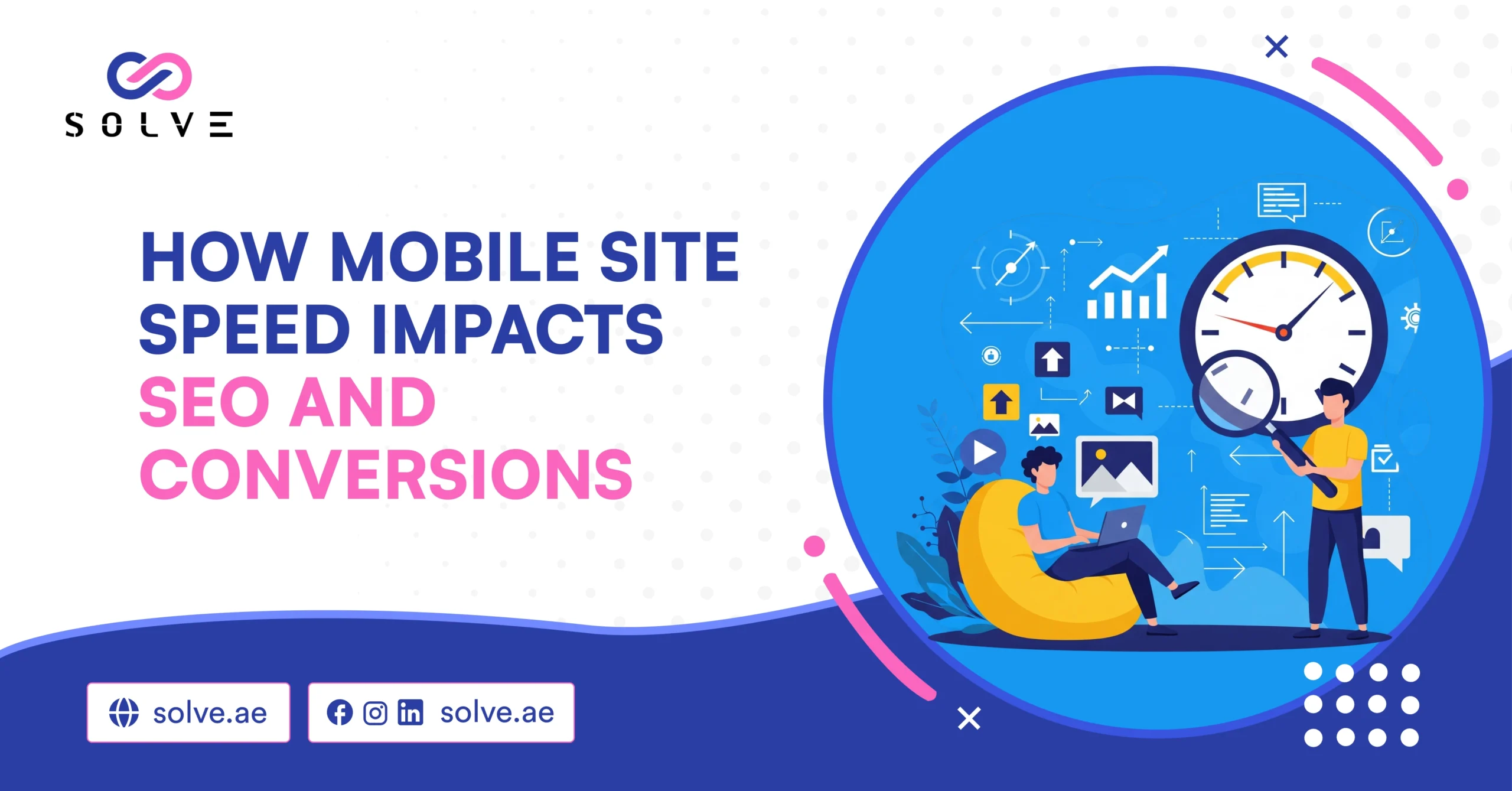- By Vanshika Choudhary
- June 21, 2025
A mobile website’s speed is all about success in digital marketing today. With mobile devices taking in the bulk share of web traffic in 2025, the user expects a lot, and they would give you rankings, customer conversions, and some income if they go down to the slightest obstruction in the way of a server response! This larger scope of blogging gets into the aspects of mobile site speed on SEO and conversions, why it is important than ever, and what operational steps need to be undertaken to present both users and search engines with an optimized mobile experience.
Why Mobile Site Speed Matters in 2025
Dominance of Mobile Traffic
Mobile devices now account for over 64% of web traffic and are the main platforms for engagement and conversion. With mobility so present, users are expecting the fastest browsing experience, irrespective of their network or device. Unlike desktop, slow mobile experiences could kill the purpose of your digital presence, as you may have lost at least 60% of your prospective audience even before they lay eyes on your content. This realization means that optimizing for mobile speed is not just good engineering practice; it is a business imperative that fosters visibility, engagement, and wallet-closing.
User Expectations and Behavior
Consumers today are less tolerant of slow loading times; the research below claims an abandonment rate of 53% occurring after just three seconds of waiting for a mobile site to load. Such impatience arises from instant gratification expectations, which have become standard in a high-speed world with powerful mobile handsets. Faster-loading sites keep users longer, make them browse, and convert. Delays invariably cause aggravation, raise bounce rates, and send negative engagement signals to search engines.
First impressions count toward brand perception.
If the first seconds are already being spent evaluating your brand, studies show users can form opinions about your website within milliseconds; a slow mobile site loading will negatively impact perception, and it cannot be reversed. This bad first impression will not just affect immediate engagement but could also harm future visiting intent, thereby affecting long-term brand loyalty and customer retention.
How Mobile Site Speed Affects SEO and Conversions
Core Web Vitals from Google, namely Largest Contentful Paint, First Input Delay, and Cumulative Layout Shift, now work as ranking signals on a mobile-first SEO and Conversions scale. These measures include load speeds for content, the time taken by users to interact, and the layout stability when loading. In 2025, Google will have tougher restrictions on each of these parameters, and it is more relevant than ever for webmasters to aim above these set realizations if they want to maintain or improve their search rankings.
Mobile-First Indexing
It continues to work on the principle of mobile-first indexing, which means that the ranking principally depends on your mobile site performance and not on your desktop version. If your mobile site is sluggish or not optimized adequately, then in the eyes of Google, the whole website’s visibility can be affected.
Bounce Rates and Engagement Signals
Users abandon slow-loading mobile sites, thereby leading to higher bounce rates. Bounce rate is a negative ranking signal, meaning search engines interpret it as a site not fulfilling its user requirements. check out our latest blog post on Essential Mobile Optimization Techniques for 2025
Crawl Efficiency and Indexation
Search engines limit the crawl budget for every website. If your website handles slow speed on mobile devices, then the search engines themselves might not even crawl or index all the content! This shrinks the chances of your site appearing on account of important keywords. In contrast, the faster your website, the easier it will be for search engines to discover new content and index it, ensuring that your recent updates will be present in search results.
The Impact of Mobile Site Speed on Conversions
Direct Correlation Between Speed and Conversion Rate
There exists an empirically measurable trend in the conversion rate of a mobile website. If a website loads in one second, it gets more than 2.5 times the conversion rate of one that loads in five seconds. If a delay of more than one second occurs in loading, it can lessen conversion rates by 7%, which simultaneously translates to huge losses in revenue for e-commerce sites.
Frictionless User Experience
A fast and responsive mobile site fosters a user experience where friction is curtailed, thereby encouraging users to take an intended action: purchase, subscribe to a newsletter, or fill out a contact form. The more effortless it becomes for a user to navigate through your site without hitting any interruptions, the more likely the user is to actualize these actions, thereby increasing conversion rates and furthering your business-related performance.
Cart Abandonment Rate Goes Down
SEO and Conversions with slow mobile speed acts as one of the greatest reasons for cart abandonment in e-commerce. Users tend not to complete purchases if a sluggish checkout process is in place. Mobile speed optimization lessens the friction at every step along the buyer’s journey, helping save more transactions for the bank.
Trust and Credibility
If users face some delays, they start doubting whether your business is reliable or if the site is secure, mainly on entering their payment information. Speed nurtures trust, while slowness nurtures doubt and hesitation.
Key Optimization Techniques for Mobile Site Speed
Image and Video Optimization
Images and videos frequently dominate the mobile page space. By adopting modern formats such as WebP, file sizes can be massively reduced with no quality compromise. Images that are not in the viewport may languish in lazy loading so as to load only when users scroll to them.
Server-Side Optimization
Slow server responses act as bottlenecks for the entire site. To limit server load times to less than 200 milliseconds, cache static resources, use a CDN, reduce database queries, and enable Gzip or Brotli compression. Doing so makes your site fly in the face of big traffic.
Code Optimization
Too much code slows down a mobile site. Minify CSS, JavaScript, and HTML to remove unnecessary characters and whitespace. Remove unused code and defer non-critical JavaScript to allow the highest priority content to be loaded first. Serve styles and scripts for above-the-fold content first to deliver a perceived faster experience to users.
Mobile-Specific Adjustments
Keep the needs of mobile users in mind for your web design, eliminating resource-heavy elements such as sliders and animations that slow down load time. Use responsive ads with lazy loading alongside an optimization scheme for variable network speeds so that the user gets a consistent experience across all device scenarios.
Testing and Monitoring
Do the speed test of your mobile site frequently with tools such as Google Lighthouse, PageSpeed Insights, and Search Console’s Page Experience reports. These tools give actionable insights for tracking your Core Web Vitals, finding bottlenecks, and taking action on resolving them. Continuous monitoring will keep your site fast even as you keep changing content and features.
Competitive Advantage for 2025
Standing Out in a Crowded Market
Keeping a superior mobile site speed will be your souvenir to the memory of the times; otherwise, advanced tech is adopted widely by business entities, and mobile optimization has become an open common practice. A fast site will be better on ranking but best on retaining users, also, best at converting; hence, a tangible competitive edge in this crowded digital marketplace.
Building Trust and Long-Term Loyalty
The SEO and Conversions advantages of maintaining speed over time will stretch into the world of trust and return visits. Should users like their experience on a site, they would return and perhaps be able to promote it in their circles, eventually bringing real customers. So long-term speed does not just speak of technicalities; it speaks of forming a bond and tending to conditions in growth.
Conclusion
By the year 2025, time on mobile sites shall no longer be considered a luxurious service but shall be taken as a basic necessity in SEO and Conversions. With mobile traffic constituting most of the web traffic, users at the highest-ever expectancy, and search engines considering speed as a factor, businesses cannot afford to ignore mobile performance. Contact us as Work on mobile-specific optimization images, servers, codes, and user experience, which will give more weight to search rankings and at the same time place the smoothest conversion path for any visitor. In a fast lane so digital, each second counts; hence, keep mobile sites in speed for success and sustainable growth.




